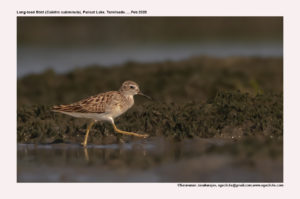
Long-toed Stint Calidris subminuta
Etymology:
- Calidris : Greek word for grey-coloured waterside bird mentioned by Aristotle
- Subminuta : Latin word sub near to; specific name Tringa minuta for little stint
Vernacular Names: Ta: Pachai kaal kosu ullan, Mar: Lamb Botancha Tilawa
Distribution in India: Winter visitor in East India and some parts of Tamilnadu
Description: Size of 13–16 cm, wt. of 20–37 g, wingspan of 26–35 cm. It is a small, slim stint with relatively long neck, legs and long toes project beyond tail in flight. It has a short bill; rufous crown and rufous ear-coverts, with dark streaks. It has a prominent whitish supercilium and narrow dark loral stripe; nape, neck and flanks are pale rufous, rufous-tinged breast is finely streaked dark brown. The upperpart feathers have dark brown centres and rufous and pale buff fringes. The female is similar but slightly larger. The non-breeding adult has upperpart feathers with black-brown centres and grey edges. The crown, neck and ear-coverts are grey, finely streaked; breast is suffused grey-brown with faint streaks on sides and flanks. The Juvenile is similar to breeding adult but streaking on breast is finer and more contrasting pattern on mantle and scapulars. The rufous crown contrasts with white supercilium; head, neck and breast are streaked.
Habitat: It breeds in wide variety of subarctic and boreal open habitats, often in open bogs or mountain tundra in taiga zone. In breeding season it is found up to 1100 m. In non-breeding season it prefers inland wetlands, rice fields, muddy or vegetated edges of coastal and sub-coastal shallow freshwater and brackish wetlands, sewage farms, salt works and saltmarshes.
Food Habits: It eats insects, small gastropod molluscs, crustaceans and seeds. It feeds among vegetation at water’s edge; often pecks prey items from mud or water surface. It feeds singly or in small flocks with other Calidris species
Breeding habits: They breed in Jun to Jul. They have high degree of site fidelity. The nest is a shallow depression filled with leaves, well hidden. They lay a clutch of 3-4 eggs. Incubation is done by both parents. Only the male tends brood.